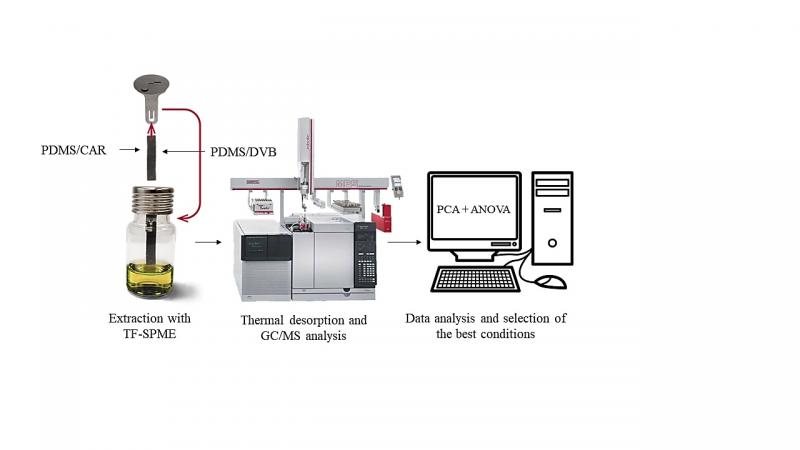It is well known that the aromatic composition of the grape is directly associated with the final quality of the wine. This composition depends on several factors such as grape variety, climatic conditions, viticultural practices, .... To understand the chemical nature of wine, it is necessary to know and determine the aromatic compounds that are present in grapes. The problem is that these compounds are found in very low concentrations in the musts, so an effective preconcentration method is necessary prior to their analysis in order to identify and quantify them.
In recent years, different techniques have been used to preconcentrate and extract the volatile compounds from the must. From the most classical ones, such as liquid-liquid extraction (LLE) and solid-phase extraction (SPE), to more modern ones such as solid-phase microextraction (SPME) and stir bar sorptive extraction (SBSE). The last two are the most efficient in terms of sensitivity, reagent and sample consumption, and automatization. Compared to SPME, SBSE increases sensitivity by a factor of 50-250 times. However, SBSE still does not have enough absorbents to cover the full range of polarities of volatile compounds in the must. For this reason, thin-film solid-phase microextraction (TF-SPME) was developed. This technique consists of a carbon film (20 mm x 4.8 mm) coated with an absorbent material. It is used by headspace (HS) and immersion (DI). TF-SPME is more sensitive than SPME, because it has a larger phase volume. On the other hand, as it has a larger contact surface, it increases the extraction rate.
In this work, developed by the Applied Viticulture and Enology (VIENAP) group of the ICVV, the TF-SPME technique has been optimized for the first time for the extraction of volatile compounds in musts. For this aim, two types of thin films (TF), a polydimethylsiloxane/ divinylbenzene (PDMS/DVB) and polydimethylsiloxane/ carboxene (PDMS/CAR), have been used. To carry out the optimization, a randomized factorial design was performed combining the following factors and levels: extraction mode (headspace (HS), or direct immersion (DI)), stirring speed (500 and 1,000 rpm), extraction time (1, 3 and 6 hours), and extraction temperature (20, 40 and 60 ºC). Once the compounds were extracted, they were identified and quantified by gas chromatography-mass spectrometry (GC-MS). Finally, a principal component analysis (PCA) and a multifactorial analysis of variance (ANOVA) were performed to select the best conditions. Given the large number of data generated, José Miguel Carot, Professor at the Polytechnic University of Valencia, collaborated for its correct statistical study.
For more information:
Marín-San Román, S., Carot, J. M., Sáenz de Urturi, I., Rubio-Bretón, P., Pérez-Álvarez, E. P., & Garde-Cerdán, T. (2022). Optimization of thin film-microextraction (TF-SPME) method in order to determine musts volatile compounds. Analytica Chimica Acta, 1226, 15 September 2022, 340254.
https://doi.org/10.1016/j.aca.2022.340254








